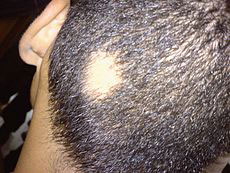
Alopecia areata is a form of non-scarring hair loss that is characterized by a round or oval patch of hair loss located on hair-bearing areas such as the scalp or the beard area. Typically on clinical examination, there is no evidence of inflammation or scarring seen. Unfortunately, alopecia areata may cover the entire scalp and eyebrows at which time it is known as alopecia totalis, and it might even also lead to complete loss of all the hairs on the body, which is known as alopecia universalis.
The age of onset is typically less than age 25. However, Dr. Behnam has seen plenty of patients who are in their mid-40s or late 50s that develop alopecia areata. It typically affects males and females equally. The etiology is unknown, however since it’s an autoimmune condition, it could be associated with other autoimmune condition such as vitiligo, thyroid disease such as Hashimoto’s disease, and Addison’s disease.
What is the Prognosis of Alopecia Aerata?
Since we are a hair clinic, we have many patients with alopecia areata in our clinic. Patients that develop alopecia areata after puberty have a very good prognosis. In these cases, the patients have a very good chance of having their hair grow back. In fact About one third the patients complete grow their hair back within 1 year and about 80% of these patients will eventually grow back their hair. However, recurrence of alopecia is common and more patches can develop throughout the scalp. Overall developing alopecia areata as an adult has better prognosis compared to patients who develop it at a younger age
What is Aloepcia Aerata?
Aloepcia Aerata is characterized by areas of round to oval patches of hair loss on the scalp or the beard area. It is an autoimmune condition where the hair follicles are attacked by inflammatory cells, thus hindering their growth.
Is Alopecia Aerata contagious?
No. Aloepcia Aerata is not caused by a virus or bacteria. It is an autoimmune condition that causes hair loss on the scalp or beard area.
How likely is it to lose all of the scalp hair?
Most of our patients have the localized form of alopecia areata on the scalp. Unfortunately, we have several patients who started out with a few patches of alopecia areata on the scalp that expanded to the entire scalp and then eventually the eyebrows, known as alopecia totalis. However this scenario is rare. Alopecia universalis is very rare as well. Alopecia Universalis means that all the hair on the body is affected and lost.
What are the treatment options for Alopecia Aerata treated?
Although in most patients alopecia areata will eventually grow back on its own if given enough time, the use of intralesional steroid Kenalog will help facilitate the hair growth. Typically intralesional Kenalog ranges from 2.5 mg/cc to 10 mg/cc. The area is first cleansed and the intralesional Kenalog is injected within the skin. One of the potential side effects of intralesional Kenalog injection is that it can cause thinning and atrophy of the scalp; however, this is rarely seen even at a 10 mg/cc concentration. On the face such as eyebrows and the cheek areas, Dr. Behnam reduces the concentration of intralesional Kenalog to 2.5 mg/cc. One must make sure to inject the steroid within the epidermis or the dermis. Kenalog should not be injected into the subcutaneous fat, as this may increase the risk of atrophy of the skin.
The patient typically comes back every 3 to 4 weeks for intralesional Kenalog injection. Other treatment methods may include systemic oral steroids; however, alopecia returns after discontinuation of the oral steroids. In some patients we do try to induce an allergic reaction by the use of squaric acid. However, most patients cannot tolerate the discomfort. For the most part intralesional Kenalog injection is the standard of care and over 95% of the patients respond very well to the treatment.
How many treatments of Kenalog injections do I need?
Typically, multiple sessions, typically, 4 to 6 sessions, of Kenalog injections are needed to see improvement. Some patients may need more and some patients may need less.
Will I get more patches of hair loss?
Yes. Patients may develop more patches of hair loss throughout the years. This does not happen to all patients but may happen.
How many patients with Alopecia Areata has Dr. Behnam treated?
Dr. Behnam has hundreds and hundreds of Alopecia Areata patients who come to clinic for monthly kenalog injections of their alopecia areata.
How often should I get my Alopecia Aerata treated with kenalog injections?
Typically, the areas are injected every 3 to 4 weeks for about 4 to 6 sessions.
How soon will I get to see improvement?
Typically improvement in hair growth is seen after the 2nd or 3rd session.
Where can I find a doctor who treats Alopecia Aerata in Santa Monica and Los Angeles, California?
Dr. Behnam, U.S. leading dermatologist and recognized nationally by Newsweek as top 10 Physicians and Surgeons in the US, is a Board Certified Dermatologist practicing in Los Angeles, CA. Dr. Behnam sees many alopecia areata and hair loss patients in Santa Monica, Los Angeles, California. Dr. Behnam’s office location is close to the freeway, thus he serves everyone in the Santa Monica area, Pacific Palisades, West Los Angeles, Beverly Hills, Culver City, West Hollywood, Hollywood and the greater Los Angeles County.
